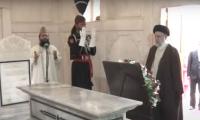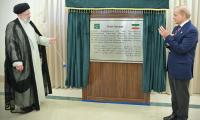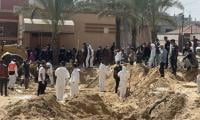Each year, Pakistanis celebrate March 23. This year we should examine exactly what is being commemorated, and how it can be renewed.
Two major events that have shaped Pakistan took place on March 23. The Lahore Resolution of March 23, 1940, and the adoption of the first constitution of the country, on March 23, 1956. It has been 81 years since the Lahore Resolution, and 65 years since the first constitution came to be. What ideals were these two important events and documents seeking to emphasize and celebrate?
Both the Lahore Resolution and the 1956 constitution affirm three principles above all. First, that Muslim identity in South Asia required a protective canopy that only a nation-state could provide. Second, that the defining governance principle of such a nation-state would be federalism, so that constituent units within this nation-state would enjoy the autonomy that is synonymous with the notion of freedom. Third, that pluralism, and especially the safety, well-being and robustness of minorities, in such a nation-state would be sacrosanct. Muslim. Federal. Pluralist.
To many, this is an uncomfortable mix. The way we try to deal with the discomfort of model ‘Pakistan’ is to either declare it to be an utter failure, or to declare it to be a roaring success. Both cases require us to deal with the cognitive dissonance of such extreme positions, by either pretending that some facts do not exist, or by arguing about the model itself.
Some Pakistanis of the secular bent of mind argue that the notion of ‘Muslim’ identity was not central to either Quaid e Azam’s approach to the departure of the British from South Asia, nor germane to the Pakistani movement. Other Pakistanis, informed by their commitment to political Islam, argue against the notion of federalism and pluralism, as both would seem to diminish the capacity of an all-powerful, absolute central state with unchallenged authority. Why such a tendency for fantasy-fiction on either end of the spectrum?
At least part of the story is the tragic compulsion we have developed of ignoring facts. The Lahore Resolution was authored by Sir Zafrullah Khan, an Ahmadi. It was presented by a founding father of Pakistan, staunch Muslim League activist and champion of the Bengali language, Sher-e-Bangla, AK Fazlul Haq. The Delhi Resolution of 1946, a follow-up to Lahore, was presented by another freedom fighter for Pakistan, and Bengali leader, Huseyn Shaheed Suharwardy. That same Suharwardy later helped lead the drafting of the 1956 constitution, as law minister in the Mohammad Ali Bogra cabinet of 1953 (he later became the fifth prime minister of Pakistan).
What can we deduce from the identities of these crucial actors in the story of March 23? The most obvious is that the federal and plural character that they helped forge for Pakistan in 1940 and again in 1956 was a natural product of their own relationship with the country. In order for them to be such vital and important leaders in Pakistan, Pakistan had to be demonstrably federalist and demonstrably pluralist. At the time that they were participating in these intense and epic moments in Pakistani history, their very leadership was evidence of the federal and plural nature of Pakistan. The roots and anchor of Pakistan, as an idea and a reality, need to align with this date: March 23. Whenever they do not, bad things happen.
In 1958, Pakistan’s federal and plural character were undermined, structurally – as a military coup took place, and a soldier took the reins of power. The outcome? Unimaginable levels of discontent among the majority of Pakistanis whose language and identity were treated with disdain and contempt. Leaders of the Pakistani movement like Fazlul Haq and Suharwardy became advocates for linguistic politics in East Pakistan.
In thirteen short years, the excitement and vitality of the idea of Pakistan turned into the tragedy of 1971. One of the young heroes of the Pakistan movement in 1947, Sheikh Mujib ur Rehman, became the leader of a separatist movement from that very Pakistan. The 1971 partition of Pakistan was many things, but above all it was a culmination of the violation of the spirit and the deed of March 23.
Eighty-one years since the Lahore Resolution, 65 years since the first constitution and almost fifty years since the separation of East Pakistan from West Pakistan, it is important for us to develop the language and tools to be able to learn from these events, commit to never allowing the horrors of 1971 to ever take place again, and renew hope and optimism for this country.
In order to develop such language and such tools, one need not embrace coercion and brute force, illegitimate authority or a denial of history. But one must accept that these dynamics make the task much harder. You can fight fire with fire. But if you are holding a patchouli-scented candle, and you are confronted with a flamethrower, the contest is no contest at all. How then can we forge a conversation that is true, and also winning?
Above Muslim identity, above a federal system of governance and above the normative centrality of pluralism – March 23 was about a free people. Can we frame freedom in 2021 in a way that aligns with March 23, but is built for the Pakistan of today, rather than the Pakistan of 1958, 1978 or 1999? This is not only possible, but imperative.
What are the principal threats to the freedom of a Pakistani in 2021?
Terrorism is an obvious one – and given the reported resurgence of the TTP, one that is current and alarming. Information warfare that disables constructive engagement and incentivizes divisiveness is also an important one. India has proactively sought to ‘isolate’ and ‘punish’ Pakistan, and its support for terrorists targeting Pakistan is undeniable. But these threats – terrorism, disinformation and India – are traditional threats. Pakistan has a reasonable track record of success in recent years of dealing with these threats. It has beat the TTP on the ground, the Indians in the air, and disinformation in the mind. It can do it again. These threats are therefore not existential. They are manageable. They will, inshaAllah, never undermine Pakistani freedom.
There are other threats that can enslave the Pakistani, extinguish the agency of the Pakistani, and swallow the freedom of the Pakistani. The most potent of them all is hunger and want. Poverty divides Pakistan more clearly and starkly than anything else can. Gender divides Pakistan too – women and girls are denied the same God-given, Islamically-guaranteed freedoms that men are provided on a platter.
Age divides Pakistan as well – more than half the country is under the age of 25, but all of the country’s decisions are taken by people above the age of 55. Cities and villages divide Pakistan too, with more and more villagers trading in lack of freedom in the village for enslavement to Pakistan’s broken and broke cities. More opportunity, more vulnerability, as little or less freedom as before. More and more, climate change will divide Pakistan – consuming all of our freedoms, a little bit at a time. What value is freedom if you are hungry, thirsty, disenfranchised, discontent and constantly dodging a predatory system built only for the elite?
In the last decade, Pakistan’s brave airmen, seamen, soldiers and spies have proven that our freedom can never be threatened by India, by terrorists, or even by disinformation.
The true threat to our freedoms lies within. False and misleading notions of how to fix our federal system by making it less federal is one of those threats. But underneath all these macro-level issues and ideas is something much simpler and more urgent. Pakistani freedom cannot be reconciled with world-beating poverty, world-beating numbers of out-of-school children, world-beating maternal mortality, world-beating polio numbers, world-beating fiscal deficits, and world-beating elite capture.
This March 23, we need to renew Pakistani resolve to win true freedom for Pakistan: from Khyber to Karachi, an economically secure Pakistan. To a woman, child and man.
The writer is an analyst and commentator.
An aeroplane of the national flag carrier of Pakistan is seen in this file photo. — AFPWhile Pakistan considers...
Representational image of a graph depicting various variables. — APP/FileInitiated by the centre and fiercely...
In this picture taken on April 16, 2023, people throng a market area during shopping in Lahore. — AFPOne of the...
Honour crimes also target men. In Sikandar Ali Lashari vs The State, SHC upheld conviction passed by ATC for honour...
If Sindh earmarks Rs20 million per police station, it will cost only Rs10 billion to make them effective first...
A complex and difficult policy environment seems to be highlighted by US’s recent application of sanctions on...







